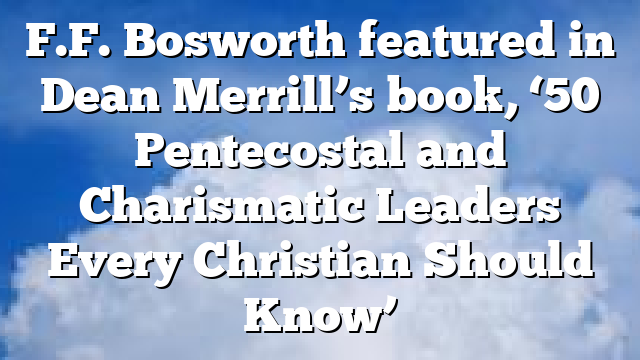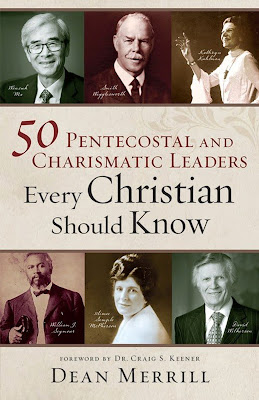Click to join the conversation with over 500,000 Pentecostal believers and scholars
Click to get our FREE MOBILE APP and stay connected
| PentecostalTheology.com



By Roscoe Barnes III, PhD
Author, F.F. Bosworth: The Man Behind “Christ the Healer”
Copyright © 2021
#FFBosworth
#BosworthMatters
Author, F.F. Bosworth: The Man Behind “Christ the Healer”
Copyright © 2021
#FFBosworth
#BosworthMatters
F.F. Bosworth is one of many Pentecostal leaders featured
in Dean Merrill’s book, “50 Pentecostal and Charismatic Leaders Every Christian Should Know” (Chosen Books, 2021). The book, which is similar to Lester Sumrall’s“Pioneers of Faith” (Harrison House, 1995), is a collection of profiles that
provides a brief overview of Pentecostal and charismatic leaders who played important
roles in revival movements and church history. As for Bosworth, Merrill
describes him as “a man who wanted to hear from God equally as much as to speak
for God and be the conduit of His healing power.”
The book features a long list of names that are well
known. In addition to Bosworth, the list includes such luminaries as Maria
Woodworth-Etter, Smith Wigglesworth, Charles Mason, William J. Seymour, John G. Lake, Aimee Semple McPherson, Donald Gee, Agnes Sanford, David du Plessis,
Gordon and Freda Lindsay, Wonsuk and July Ma, Dennis and Rita Bennett, John and Elizabeth Sherrill, Francis and Judith MacNutt, Jack Hayford, Oral Roberts,
William Branham, Harald Bredesen, Jane Hansen Hoyt, and John Wimber.
known. In addition to Bosworth, the list includes such luminaries as Maria
Woodworth-Etter, Smith Wigglesworth, Charles Mason, William J. Seymour, John G. Lake, Aimee Semple McPherson, Donald Gee, Agnes Sanford, David du Plessis,
Gordon and Freda Lindsay, Wonsuk and July Ma, Dennis and Rita Bennett, John and Elizabeth Sherrill, Francis and Judith MacNutt, Jack Hayford, Oral Roberts,
William Branham, Harald Bredesen, Jane Hansen Hoyt, and John Wimber.
Dr. Craig S. Keener, who wrote the Foreword, describes
the book as “a handy primer on most of the leading figures — a valuable
refresher for those schooled in Pentecostalism and a crucial survey to initiate
beginners.” As such, the book is sure to answer questions, fill in gaps,
inspire, and perhaps invigorate a new generation in the study of Pentecostal
church history.
the book as “a handy primer on most of the leading figures — a valuable
refresher for those schooled in Pentecostalism and a crucial survey to initiate
beginners.” As such, the book is sure to answer questions, fill in gaps,
inspire, and perhaps invigorate a new generation in the study of Pentecostal
church history.
As the author, Merrill continues to add to an already impressive
career. He is the former editor of Campus Life and Leadership Journal. He also
served as editorial director for David C. Cook and Focus on the Family. He has
written 10 books and co-authored 39 others, according to his bio. Some of his
titles have been ranked on New York Times bestseller lists.
career. He is the former editor of Campus Life and Leadership Journal. He also
served as editorial director for David C. Cook and Focus on the Family. He has
written 10 books and co-authored 39 others, according to his bio. Some of his
titles have been ranked on New York Times bestseller lists.
Note: John
Lathrop wrote an excellent review of this book for The Pneuma Review. It can be
read here.
Lathrop wrote an excellent review of this book for The Pneuma Review. It can be
read here.
Key moments in Bosworth’s life
Merrill’s 282-page volume gives readers a quick overview
of the key moments in Bosworth’s life history. He opens the chapter with
Bosworth’s dilemma in Lima, Ohio. Bosworth had been asked to preach on the
subject of divine healing. He believed in healing, but he wrestled with the
fact that all were not healed in answer to prayer. After some reflection and
prayer, he concluded it was his job to preach and pray for the sick, and to
leave the results to God. He’d asked, “Lord, suppose I preach on healing, and
the people come and don’t get healed?” The Lord reportedly replied, “If people
didn’t get saved, you wouldn’t stop preaching the Gospel.” From that point, Bosworth
began preaching the message of salvation and healing with unrelenting boldness.
of the key moments in Bosworth’s life history. He opens the chapter with
Bosworth’s dilemma in Lima, Ohio. Bosworth had been asked to preach on the
subject of divine healing. He believed in healing, but he wrestled with the
fact that all were not healed in answer to prayer. After some reflection and
prayer, he concluded it was his job to preach and pray for the sick, and to
leave the results to God. He’d asked, “Lord, suppose I preach on healing, and
the people come and don’t get healed?” The Lord reportedly replied, “If people
didn’t get saved, you wouldn’t stop preaching the Gospel.” From that point, Bosworth
began preaching the message of salvation and healing with unrelenting boldness.
Merrill follows this section with two widely known cases
of healing in Bosworth’s ministry. The first case is about the school for the
deaf in Chicago in the 1920s where multiple students were reportedly healed
through Bosworth’s ministry. David J. du Plessis mentioned the healings in the April 1958
issue of World-Wide Revival. He wrote:
of healing in Bosworth’s ministry. The first case is about the school for the
deaf in Chicago in the 1920s where multiple students were reportedly healed
through Bosworth’s ministry. David J. du Plessis mentioned the healings in the April 1958
issue of World-Wide Revival. He wrote:
Fred Bosworth received a lot of publicity in the Chicago
Daily News and other metropolitan newspapers when a large number of students
who were attending a school for the death were miraculously healed, their
healings causing the school to close.
Daily News and other metropolitan newspapers when a large number of students
who were attending a school for the death were miraculously healed, their
healings causing the school to close.
The second case is the story of John Sproul, a war
veteran, whose healing testimony appeared in the Oct. 19, 1921, issue of the
Pittsburgh Post-Gazette. Sproul had lost his voice about three years earlier
following a gas attack on the battlefields of France. Sproul testified to being
healed in a revival meeting that was held by F.F. Bosworth and his brother, B.B. Bosworth.
veteran, whose healing testimony appeared in the Oct. 19, 1921, issue of the
Pittsburgh Post-Gazette. Sproul had lost his voice about three years earlier
following a gas attack on the battlefields of France. Sproul testified to being
healed in a revival meeting that was held by F.F. Bosworth and his brother, B.B. Bosworth.
Other topics in Bosworth’s story
In telling Bosworth’s story, Merrill also writes about:
* The publication of Bosworth’s book, “Christ the Healer,”
in 1924.
in 1924.
The book is a compilation of Bosworth’s sermons on divine
healing. Today, in 2023, the book is still in print. Over the years, its
individual chapters have appeared as articles in magazines. Audio recordings
have been made of the entire book.
healing. Today, in 2023, the book is still in print. Over the years, its
individual chapters have appeared as articles in magazines. Audio recordings
have been made of the entire book.
* Bosworth’s famous debate on divine healing with the
Rev. W.E. Best in 1950 in Houston.
Rev. W.E. Best in 1950 in Houston.
At the time, Bosworth was holding revival meetings with
William Branham. During the debate, Rev. W.E. Best, a Baptist pastor, argued for
cessationism. However, Bosworth argued using the promises of God in the
Scriptures and the testimonies of those who professed they had been healed.
Merrill writes:
William Branham. During the debate, Rev. W.E. Best, a Baptist pastor, argued for
cessationism. However, Bosworth argued using the promises of God in the
Scriptures and the testimonies of those who professed they had been healed.
Merrill writes:
“Eventually Bosworth asked everyone who had been cured by
faith to stand. Hundreds arose. After they sat down again, followed up with “How
many of you are Baptists?” According to one news paper report, ‘At least 100
stood up.’”
faith to stand. Hundreds arose. After they sat down again, followed up with “How
many of you are Baptists?” According to one news paper report, ‘At least 100
stood up.’”
* Bosworth’s Pentecostal experience.
Here, Merrill makes a remarkable claim that is
questionable. He writes: “Bosworth spoke in tongues himself (following the 1906
laying on of hands by Pentecostal pioneer Charles Parham), and so did many in
his meetings.” Merrill does not cite a source for this claim.
questionable. He writes: “Bosworth spoke in tongues himself (following the 1906
laying on of hands by Pentecostal pioneer Charles Parham), and so did many in
his meetings.” Merrill does not cite a source for this claim.
Merrill correctly notes that Bosworth, a founding father
of the Assemblies of God, left the denomination over the issue of evidential
tongues. Bosworth opposed the view that speaking in tongues was the only
initial evidence of Spirit baptism.
of the Assemblies of God, left the denomination over the issue of evidential
tongues. Bosworth opposed the view that speaking in tongues was the only
initial evidence of Spirit baptism.
* Bosworth’s persecution in Hearne, Texas.
Bosworth suffered a severe beating by a mob of white men after
he preached to a black audience at a camp meeting in 1909. The racist mob
threatened him, beat him with boat oars and a baseball bat, and literally ran
him out of town.
he preached to a black audience at a camp meeting in 1909. The racist mob
threatened him, beat him with boat oars and a baseball bat, and literally ran
him out of town.
*Bosworth’s embrace of British-Israelism.
Merrill writes, “It must be admitted that his theological
compass wasn’t perfect. In the mid-1930s, he began to espouse an error called
British-Israelism, the notion that the people of the British Isles (and their
American cousins) were the direct descendants of the ‘Ten Lost Tribes’ of
Israel, and therefore preferred by God.”
compass wasn’t perfect. In the mid-1930s, he began to espouse an error called
British-Israelism, the notion that the people of the British Isles (and their
American cousins) were the direct descendants of the ‘Ten Lost Tribes’ of
Israel, and therefore preferred by God.”
* Bosworth’s influence on the post-World War II healing
revival.
revival.
Bosworth served as a mentor to the revivalists in the
healing revival of the 1940s and 1950s. His book, “Christ the Healer,” became a
veritable textbook for pastors and evangelists during this time. He also served
as an active member of The Voice of Healing, where he worked with Gordon
Lindsay and other healing evangelists.
healing revival of the 1940s and 1950s. His book, “Christ the Healer,” became a
veritable textbook for pastors and evangelists during this time. He also served
as an active member of The Voice of Healing, where he worked with Gordon
Lindsay and other healing evangelists.
Conclusion
Merrill ends his chapter with a story about Bosworth
visiting the home of a young T. L. Osborn, who was living in a parsonage. When Bosworth
entered the home, he learned that Osborn was upstairs praying, making “loud and
impassioned pleas for God to bless and meet all kinds of needs.” When Osborn
was finally done, Bosworth said, “You know, Tommy, the Lord’s an awfully good
gentleman. He won’t ever butt in as long as you’re doing all the talking!”
visiting the home of a young T. L. Osborn, who was living in a parsonage. When Bosworth
entered the home, he learned that Osborn was upstairs praying, making “loud and
impassioned pleas for God to bless and meet all kinds of needs.” When Osborn
was finally done, Bosworth said, “You know, Tommy, the Lord’s an awfully good
gentleman. He won’t ever butt in as long as you’re doing all the talking!”
Most of the people featured in Merrill’s book are probably
well known to the readers of such books as “All
Things Are Possible” by and the “Dictionary
of Pentecostal and Charismatic Movements” by
well known to the readers of such books as “All
Things Are Possible” by and the “Dictionary
of Pentecostal and Charismatic Movements” by
————————-
Note: My book, F.F. Bosworth: The Man Behind “Christ the
Healer,” can be purchased here with a 25% discount. Use the discount code (all
caps): BOSWORTH25.
Healer,” can be purchased here with a 25% discount. Use the discount code (all
caps): BOSWORTH25.
—————————————————————————–
Want to know more
about F.F.
Bosworth?
Bosworth?
Follow the Bosworth
Matters blog!
Matters blog!
Start here:
—————————————————————————–
For more information:
Visit the F.F. Bosworth page here. Questions
about the research and commentary on F.F. Bosworth may be directed to Roscoe Barnes III, Ph.D.,
via email at doctorbarnes3@gmail.com or roscoebarnes3@yahoo.com. For updates on
F.F. Bosworth history, simply follow this blog or @bosworth_fred and
@Roscoebarnes3 on Twitter. #ChristTheHealer #BosworthMention #BosworthMatters
about the research and commentary on F.F. Bosworth may be directed to Roscoe Barnes III, Ph.D.,
via email at doctorbarnes3@gmail.com or roscoebarnes3@yahoo.com. For updates on
F.F. Bosworth history, simply follow this blog or @bosworth_fred and
@Roscoebarnes3 on Twitter. #ChristTheHealer #BosworthMention #BosworthMatters



